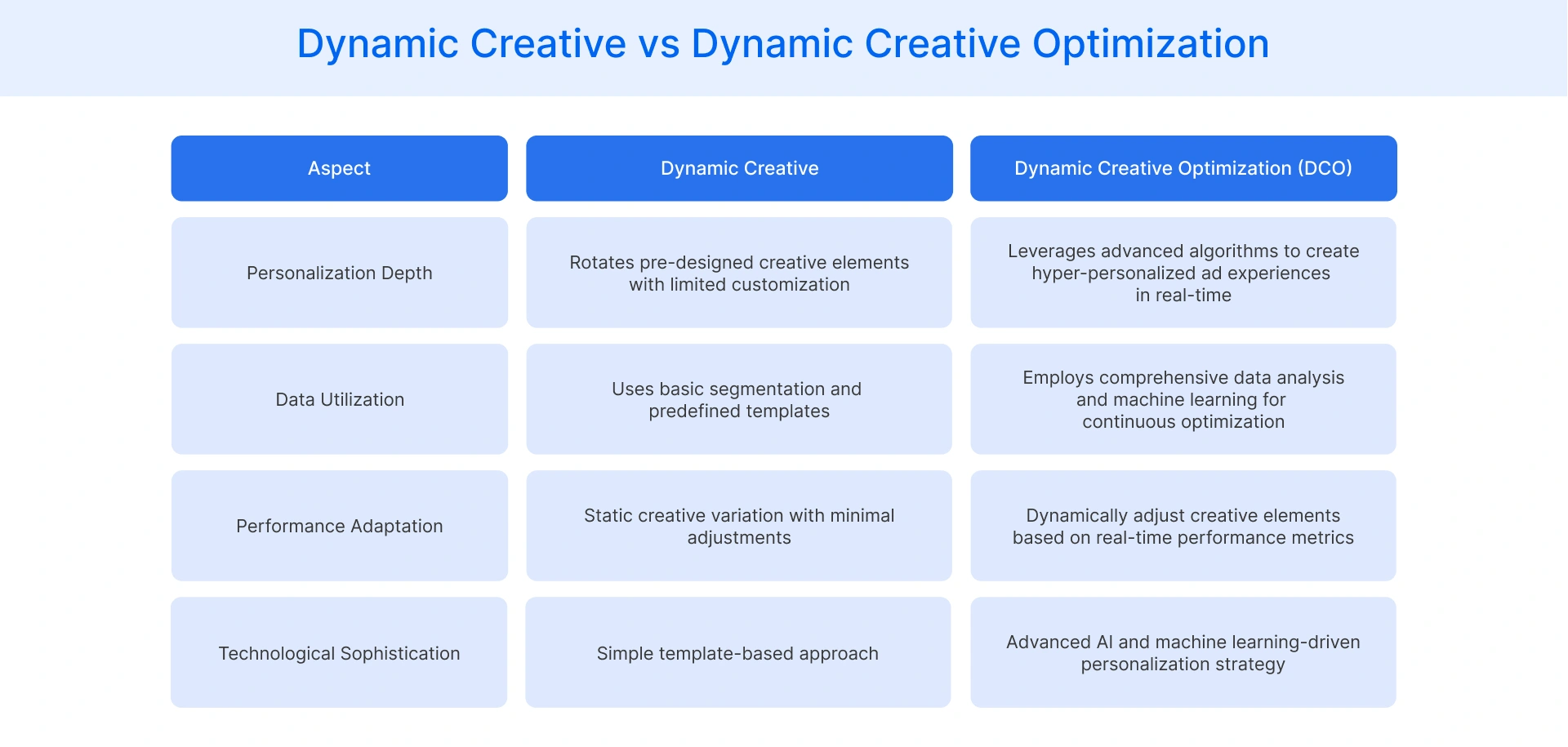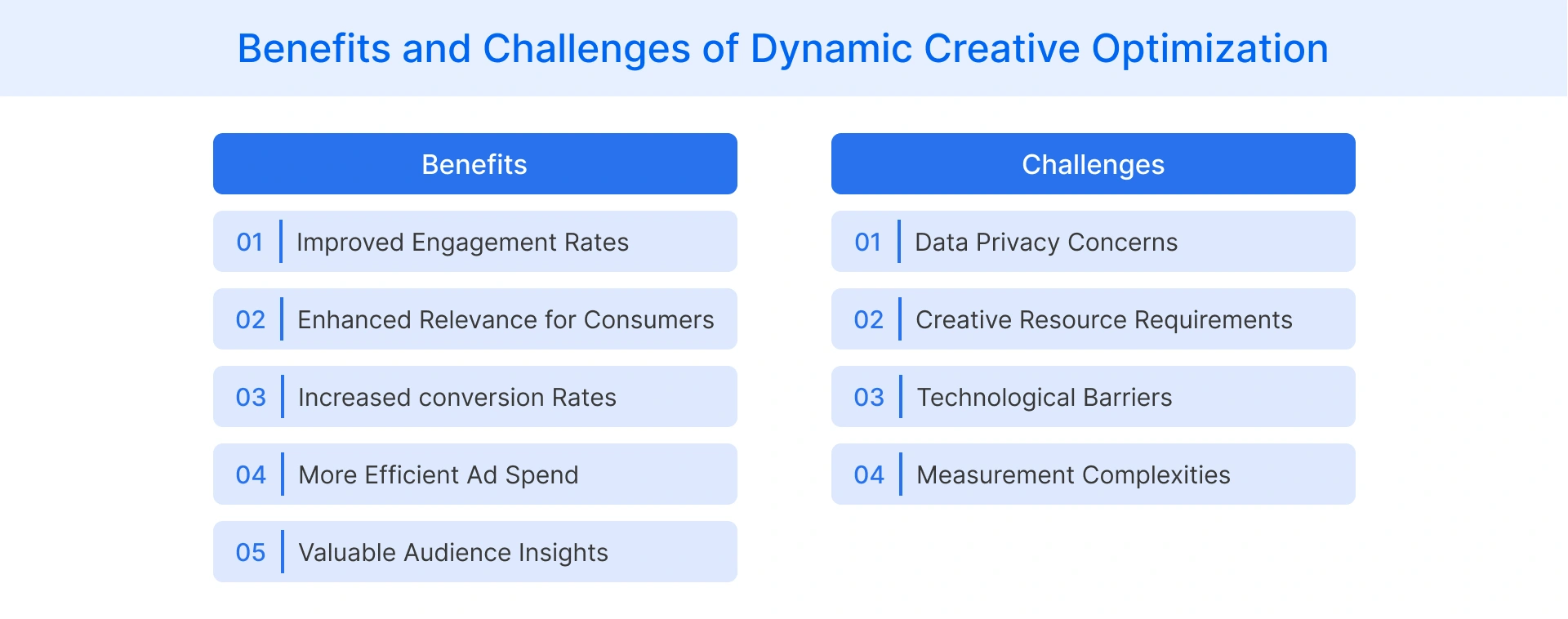Table of Contents
- What is Dynamic Creative Optimization
- Why is Dynamic Creative Optimization Important
- How to Create a Dynamic Creative Optimization Campaign
- What are the Differences Between Dynamic Creative vs. Dynamic Creative Optimization
- Does Dynamic Creative Optimization Rely on Cookies or Tracking Technologies
- What are the Benefits of Dynamic Creative Optimization
- How to Address the Challenges in the Implementation of Dynamic Creative Optimization
What is Dynamic Creative Optimization?
Dynamic Creative Optimization (DCO) is an advanced technology that automates the real-time assembly of personalized ad creatives. DCO utilizes data inputs to deliver the most relevant ad content, like headlines, images, and calls to action, to each unique viewer. This ensures a highly customized ad experience compared to traditional static ads.
This sophisticated mechanism drives ad relevance through key components.
- Real-time data streams provide crucial insights for immediate ad personalization.
- Advanced algorithms analyze user preferences and contextual signals for optimal ad delivery.
- Automation ensures efficient delivery of tailored ad creatives across various platforms, including social media.
- Machine learning continually refines ad element selection, enhancing overall campaign performance.
- Artificial intelligence customizes content based on user behavior and other dynamic attributes.
- DCO precisely adapts ad creatives to device type, location, and time of day.
Why is Dynamic Creative Optimization Important?
Dynamic Creative Optimization allows advertisers to meet rising consumer demands for personalized experiences. Let’s understand the different aspects that make it an essential tool for advertising campaigns:
- Consumer Personalization: Transforms digital advertising by delivering hyper-targeted content that speaks directly to individual buyer personas, expectations, and immediate contextual needs.
- Performance Optimization: Enables marketers to dramatically improve advertising efficiency by dynamically adjusting creative elements based on real-time performance KPIs and user interactions.
- Cost-Effective Marketing: Reduces wasted ad spend by intelligently allocating resources to the most effective creative variations and targeting strategies.
- Enhanced User Engagement: Creates more meaningful connections between brands and consumers through precisely tailored messaging that resonates with specific audience segments.
- Competitive Advantage: Provides retailers and marketers with a sophisticated tool to stand out in crowded digital marketplaces or retail media ad networks, by offering unparalleled ad personalization.
What are Some Examples of Dynamic Creative Optimization?
Here are some examples of dynamic creative optimization highlighting its application in different e-commerce scenarios:
- E-commerce Product Recommendations: When a user browses specific products on an online store, DCO can dynamically generate ads showcasing those exact products. The ad might also display related items or recently viewed products, encouraging a return visit and purchase.
- Online Retargeting: If a customer adds items to a shopping cart but leaves before completing a purchase, DCO can display ads featuring those abandoned items. These ads might include limited-time offers or free shipping incentives, prompting the customer to complete their order.
How to Create a Dynamic Creative Optimization Campaign?
Setting up an effective Dynamic Creative Optimization campaign involves several strategic steps. This ensures your personalized ads deliver optimal results and achieve your marketing objectives.
Define Campaign Goals
Clearly establish what you aim to achieve with your DCO campaign. This could include increasing conversions, driving brand awareness, or re-engaging past customers effectively. Your objectives will guide creative and targeting decisions.
Gather Customer Data
Collect relevant first-party data on user behavior, preferences, and demographics. This data is fundamental for personalizing ad creatives effectively and ensuring accurate targeting. Robust data feeds are crucial for DCO success.
Design Creative Templates
Develop a range of ad creative templates with customizable elements. These templates act as frameworks, allowing DCO technology to dynamically insert product images, prices, headlines, and calls to action based on individual user data.
Select a DCO Platform
Choose a suitable Dynamic Creative Optimization platform or ad server that supports DCO capabilities. The platform should offer robust features for data integration, creative management, and real-time optimization. Evaluate options based on your needs.
Implement Tracking and Measurement
Set up comprehensive tracking mechanisms to monitor campaign performance meticulously. Track key metrics such as impressions, clicks, conversions, and return on ad spend. This data allows for continuous optimization and performance improvement.
What are the Differences Between Dynamic Creative vs. Dynamic Creative Optimization?
While both Dynamic Creative and Dynamic Creative Optimization involve variable ad elements, their core functions differ significantly.
Dynamic creative often simply rotates predetermined creative elements based on simple rules. Dynamic Creative Optimization, however, employs sophisticated algorithms to optimize creative decisions in real-time, driven by performance data and user insights.

Does Dynamic Creative Optimization Rely on Cookies or Tracking Technologies?
Dynamic Creative Optimization historically relied heavily on third-party cookies and other tracking technologies to gather user data. These traditional methods allowed DCO platforms to understand user behavior, preferences, and Browse history. This information was then used to personalize ad content in real-time, ensuring relevance.
However, with evolving privacy regulations, such as GDPR and CCPA, and changes in browser policies, the reliance on third-party cookies is diminishing. Advertisers are adapting to a more privacy-centric landscape. This shift necessitates new approaches to data collection for Dynamic Creative Optimization.
Emerging cookieless solutions are becoming increasingly important for DCO. These include first-party data strategies, contextual targeting, and identity graphs that leverage non-cookie identifiers. These innovations enable Dynamic Creative Optimization to continue delivering personalized ad experiences while respecting user privacy.
What are the Benefits of Dynamic Creative Optimization?
Implementing Dynamic Creative Optimization offers numerous compelling advantages for advertisers.
- Improved Engagement Rates: DCO delivers highly relevant ad content that captures audience attention more effectively. This increased relevance leads to higher click-through rates and greater user interaction with your advertisements.
- Enhanced Relevance for Consumers: By tailoring ad elements to individual preferences, DCO makes ads feel less intrusive and more helpful. This improves the overall user experience and builds a positive brand perception among your target audience.
- Increased Conversion Rates: Personalized ads resonate strongly with users, moving them closer to a purchase decision. The precision targeting of Dynamic Creative Optimization directly contributes to a significant uplift in conversion rates and sales volume.
- More Efficient Ad Spend: DCO optimizes ad delivery, ensuring your budget is allocated to the most effective ad variations for each user. This efficiency minimizes wasted ad impressions and maximizes the return on your advertising investment.
- Valuable Audience Insights: The data collected and processed by DCO platforms provides deep insights into consumer preferences and ad performance. This information can inform future marketing strategies and product development, offering a comprehensive understanding of your audience.

How to Address the Challenges in the Implementation of Dynamic Creative Optimization?
Implementing Dynamic Creative Optimization, while highly beneficial, can present several challenges.
- Data Privacy Concerns: Navigating stringent data privacy regulations like GDPR requires careful data handling. Implement robust data governance frameworks, ensure explicit user consent, and explore privacy-enhancing technologies to maintain compliance.
- Creative Resource Requirements: DCO necessitates a library of diverse creative assets and templates. Invest in creative development tools and potentially partner with creative agencies. This ensures a sufficient supply of high-quality, adaptable ad components.
- Technological Barriers: Integrating DCO platforms with existing marketing tech stacks can be complex. Choose platforms with strong API capabilities and ensure your IT team has the necessary expertise. Consider a phased implementation approach.
- Measurement Complexities: Accurately attributing performance to specific DCO elements can be challenging. Utilize advanced analytics tools and multi-touch attribution models. This provides a comprehensive understanding of how Dynamic Creative Optimization impacts your overall campaign results.
FAQ
AI and machine learning significantly improve DCO by automating creative selection. They analyze vast data sets to predict which ad elements will resonate best. This leads to superior personalization and efficiency.
Retailers should track key metrics like click-through rates, conversion rates, return on ad spend (ROAS), and cost per acquisition (CPA). These metrics indicate campaign effectiveness and ROI.
Yes, DCO is adapting to privacy-first strategies by leveraging first-party data. It also incorporates contextual targeting and cookieless identifiers. This enables personalization while respecting user privacy regulations.
DCO strengthens omnichannel marketing by ensuring consistent, personalized messaging across all customer touchpoints. It adapts ad creatives to user behavior, regardless of the channel, unifying the customer journey.

